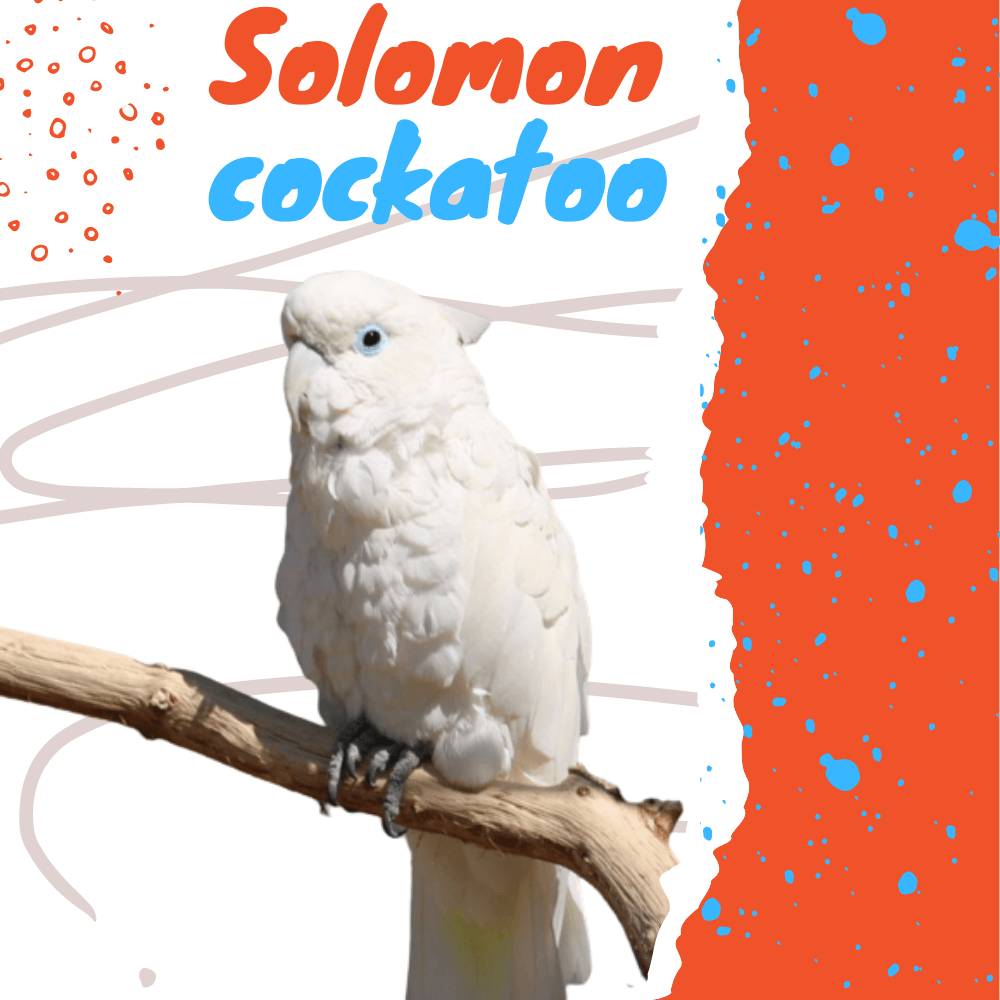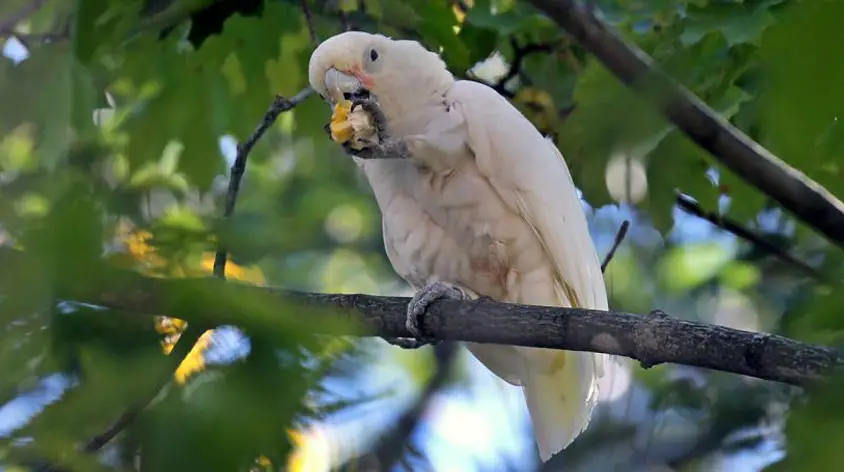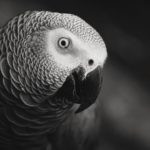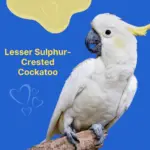
The Solomon‘s Cockatoo Cacatua Ducorpsii or Ducorp Cockatoo is a species of parrot native to the Solomon Islands. Ducorp’s Cockatoo care
It is one of the real cockatoos and, together with the Rotsteiß and Goffinkakatu, is one of the smallest species of the genus.
Solomon cockatoos are generally forest inhabitants but have increasingly developed into cultural successors who also look for food in villages and on the outskirts of cities in the Solomon Islands.
The Solomon Cockatoo reaches a body size of 32 centimeters and weighs between 300 and 450 g. As is characteristic of the genus of the actual cockatoo, its plumage is predominantly white.
Only a few head feathers are light salmon-colored at their base. The undersides of the wings and tail are yellowish. The beak is brightly horn-colored. The iris is dark brown, the eye-ring is featherless and bluish-white. The toes are gray.
There is no gender dimorphism. Females differ from males only in their rather reddish-brown iris, which only appears when they are around 2 years old. Animals not yet sexually mature are similar to adult birds.
Young animal at 10 weeks
The underside of the wing pale yellow in color
The light salmon-colored base of the head feathers
Solomon’s Cockatoo care
Habitat and food

Similar to the Moluccan Cockatoo and the Goffink Cockatoo, the Solomon Cockatoo is native to an equatorial climate. The average temperature in the Solomon Islands is 30 ° C. The amount of precipitation is subject to seasonal fluctuations, but the humidity is very high all year round.
The habitat of the Solomon Cockatoo extends from the coastal swamp areas to the wooded and humid mountain regions of these islands. They can be found up to a height of 1,700 meters above sea level.
The species is widespread in the Solomon Islands and is considered a crop pest. In the early morning and evening hours, many small groups of 5–8 birds each gather in fields (maize) and then invade the plantations in a large flock of sometimes over 100 birds.
In places where they do not live in the vicinity of human settlements, the diet of the Solomon Cockatoos consists mainly of berries, fruits, and flowers. Like many other cockatoo species, they also eat insects and their larvae.
Reproduction
There is very little information about the way of life of the Solomon Cockatoo, especially when compared to the cockatoos native to Australia. However, the breeding season sets in at the time when rainfall increases.
Solomon cockatoos are monogamous birds whose pairing lasts until one of the partners dies. They also seem to have high site fidelity. It is believed that breeding caves are used repeatedly by couples. The clutch usually consists of two to three eggs. The breeding season for Salomon Cockatoos kept in human care was 28 to 30 days.
Singing Ducorps Cockatoo
SOURCE:TheDimholt
protection
The Solomon Islands belonged to the German colonies in the period before the First World War. During this time, some Solomon cockatoos also came to Germany.
According to Dieter Hoppe, there were no more Salomon cockatoos kept in Germany in the 1980s. The same applies to other countries; the Solomon cockatoo is considered to be the species of actual cockatoo that is least cared for.
At the beginning of the 1990s, a German importer obtained permission for limited exports of some Solomon cockatoos. These specimens formed the basic European population of the species.
Solomon cockatoos should not be underestimated because of their size. They too can make significant sounds. Like all cockatoos, they are very curious and like to nibble on objects, which can cause significant damage to furniture and other items.
This can be remedied with fresh branches that are made available to the birds. Solomon cockatoos, like any parrot, should never be kept individually, but always with an opposite-sex partner.
THE DUCORPS COCKATOOS
This species is one of the least known of the genus Cacatua. This is notoriously due to the low importation of which it is the object and also to its cantankerous character.
Appellations
- Scientist: Cacatua ducorpsii
- Dutch: Ducorps kaketoe
- English: Ducorps’ cockatoo
- German: Salomonkakadu
Description
- Male: the general color is white. The head and sometimes the bust have a slightly pinkish reflection but it is difficult to realize it. The underside of the wings and tail are pale yellow. The skin around the eyes and the eye-ring are bluish. The iris is brown to black; the legs are gray and the bill is gray-white. The rounded crest is wider and longer than that of the Goffin’s Cockatoo. The male measures more or less thirty-one centimeters.
- Female: similar to male but generally smaller and the iris is reddish in color.
- Juvenile: like the adult bird but the plumage is more light gray than white and the iris is dark. The female does not acquire the red of the iris until the age of two to three years. It is, therefore, better to sex the birds to gain certainty about what you have.
- There are no subspecies.
Behavior in nature
The species live in the eastern Solomon Islands from Bougainville to Malaita. This species is not recorded on the San Cristobal Islands. Nests are found in the woods and their surroundings.
Outside of the breeding season, these birds keep in pairs or in small groups of eight. It is a fierce and very anxious species that only rests on the ground to eat and drink.
A characteristic feature of his fearful temperament is that there are always a few sentries posted high in a tree who are on the lookout for any sign that might worry them. When the alarm was given, the whole group flew away, uttering shrill cries.
In the wild, Ducorps’s Cockatoo feeds on seeds, fruits (nuts, berries), flowers, insects, and their larvae and occasionally does not disdain to taste half-ripe corn cobs.
He can prey on bananas and papayas on plantations just as he can dig for sweet potatoes. This way of feeding is in the event of major raids, deplorable for human food crops.
Reproduction
The species broods in May and the display that precedes mating is interesting to observe. The female attracts the attention of the male with rapid nods of the head and snapping of the bill.
When the male arrived, she crouched down and snuggled up against him, placing her head under the breast of her future husband. Then follows a concert of beak snap accompanied by many nods of the head.
Super cute ducorps cockatoo
SOURCE:parrot family tv
Breeding
The female lays two to three eggs which are incubated for more or less twenty-eight days. The young that emerge stay between seventy-five and seventy-nine days in the nest.
They are independent five weeks after leaving the nest. The Ducorps’s Cockatoo is a very precocious cockatoo sexually compared to other species of the genus.
There are known cases of birds having reproduced when they were barely two years old; as a general rule, it is still necessary to wait until the birds are three years old before they think of breeding.
If the hobbyist who tries to breed Ducorps’s Cockatoos is not lucky and his pair is not a good breeding pair, there are two solutions left:
- He moves the eggs to adoptive parents
- He places the eggs in an artificial incubator
The relative humidity in the latter must remain between sixty and sixty-five percent.
In captivity
The nest box intended for this species will be given the following dimensions: 25 x 30 x 50 centimeters. It is better to make it with a very solid material because as a general rule such a nesting box only lasts a year, the birds destroying it outright!
The use of a portion of a tree trunk can also be done and aesthetically speaking we can say that it is even better. Whatever model the breeder uses, he will have to clean it thoroughly by disinfecting it, I personally use a product from the Virkon ™ brand.
You have to fill the nest with peat to which you mix beech chips or ground hemp fibers. The latter material is more expensive than wood chips but provides one hundred percent disinfection.
I regularly present twigs that the birds gnaw and then place in the nest. If Cockatoos continue to demolish their nest, we can deduce that it is not suitable for them or that they lack branches to gnaw on.
Aggressiveness
As I have already pointed out, Ducorps’s Cockatoo ranks among the most aggressive Cockatoos. It can even happen that the male kills the female! If the breeder is dealing with an excited male, he can solve the problem by doing the following:
- Place the male in an aviary adjoining that of the female; when it appears less aggressive (you will notice that it will try to feed the female through the trellis), you risk bringing the two birds together.
- Place the male in a cage in the female’s aviary. We will not release him until we have the assurance that the danger has passed.
- To join the male, it should hamper his flight.
- Give the male a wide choice (several females), if necessary combine this last solution with one or other of the preceding ones.
In aviary
The ideal dimensions for birds of this species are as follows:
- Length: four meters
- Width: two meters
- Height: two meters
That is to say a volume of sixteen cubic meters.
It will be necessary to provide an adjoining shelter for the night and the bad season, the ground will have to be concreted, it will protect from frost.
The aviary cannot be too cramped to allow the female to seek refuge in the flight to escape the assiduity of the male. The uprights of the assembly should be made of metal and the mesh used very solid (wire diameter: two millimeters).
The bottom of the outdoor aviary can remain in loose soil without forgetting, however, that Cockatoos are excellent burrowers!
It is prudent to provide a solid foundation under this earth, this will prevent escapes. It also happens that Cockatoo enthusiasts use aviaries with only the front side made of metallic gauze.
The advantage of this way of acting is that the birds cannot be disturbed by neighboring birds. If the side walls are in spite of everything in latticework, it is better not to have Cockatoos nearby. On the other hand, there is nothing wrong with placing other Psittacidae next to Cockatoos.
Handfed Ducorp’s Cockatoo
SOURCE:West Coast Birds
Interesting things to know
Ducorps’s Cockatoo is very sensitive to changes in the surrounding environment. Their healer can disturb them, that’s a fact, but changes in their aviary can also.
This is the primary reason for bad, abandoned eggs containing well-developed embryos that have died or young that have died of starvation because their parents did not or no longer feed them.
Many broods must therefore be reared by hand. I have already pointed out that problems with eggs can be solved anticipatively.
This is valid for this species but also for many others, all breeders can be confronted one day or another. There are embryos that die early in the cycle and the reasons can be found in the following list:
- The eggs cooled after a few days of brooding
- The material in the nest is bad
- Too many interventions by the breeder
- Lice and ringworms
- Possible overpopulation in the aviary and subsequent competition, this is not the case with the Ducorps’s Cockatoo because due to its particularly aggressive character, birds of this species must be kept at the rate of one pair per aviary
- Bad birdhouses
- Bad parents
- Nest too hot or too cold, poorly ventilated and therefore poorly conditioned
- Disturbances due to reasons external to the nest
- Infected eggs, they always kill embryos
This last point is often due to bad food; a diet that is too little varied inevitably leads to the death of embryos. A good menu for this species should not only consist of seeds and water but also fruits and vegetables, twigs, egg mash, sepia, grit, and whatnot.
The most common infections that can be transmitted from the female to the eggs are Chlamydophilasis and Salmonella.
An egg smeared with blood should be cleaned with lukewarm water. This egg betrays the difficulty that the mother had in laying it and it can often be the basis of infection.
It happens regularly to find young dead and half-hatched in the nests. Lots of amateurs tried to help the kids out, but the kids never made it. To realize what is wrong with this way of acting, it is necessary to know the course of the birth of a “normal” bird. This happens in two stages.
In the first phase, we hear the young chickweed in the egg as it tries to make a hole in the shell. If this is successful, the youngster immediately begins to breathe the fresh air that enters through the opening.
After twelve to thirty-six hours, depending on the species, the second stage begins during which the young will want to extract himself from the cramped space of the egg at all costs, and from then on he will breathe the ambient air directly.
The timing is critical because if there is too high a temperature combined with too low humidity, the eggshell will be too hard and difficult to break.
It happens then that young birds cannot or can hardly leave the egg permanently. If the young person receives help to get out, he dies. What can be done is simply to distill three drops of lukewarm water on the young bird using a dropper.
The shell of the egg will become wetter inside and the young can be extracted without further problem. What can be done is simply to distill three drops of lukewarm water on the young bird using a dropper. The shell of the egg will become wetter inside and the young can be extracted without further problem.
What can be done is simply to distill three drops of lukewarm water on the young bird using a dropper. The shell of the egg will become wetter inside and the young can be extracted without further problem.
Ducorps Cockatoo
SOURCE:mischmetal mc
What do cockatoo eat
The seed mixture I give to my Ducorps Cockatoos consists of a small portion of sunflower seeds and pumpkin seeds and a mixture for small parakeets (round millet, hemp, buckwheat, cedar nut, flat millet, wheat, husked rice).
My birds also receive half-ripe corn on the cob, lots of fruit (apple, pear, various berries) and vegetables (butcher’s broom, beetroot), greens, and sprouted seeds.
Cuttlefish bones are always present to ensure an adequate level of calcium. A good mixture of digestive grit made from oyster scale and coarse gravel is also available to the birds.
Nuts in general have a bad reputation for spreading mold diseases, yet they are an essential part of Parrots’ food. They even seem to be beneficial for the heart.
It should not be given in too large quantities but on the other hand, Cockatoos should have the opportunity to eat them. Ducorps’s Cockatoo likes to peel common nuts (from our walnut tree) and it loves to eat hazelnuts and cedar nuts.
A word of advice: never store your nuts in a place that is too humid and especially never protected from the air. Without hesitation, throw out a damaged nut and keep in mind that the maximum shelf life for nuts is six months. However, you can freeze them.
Ducorps’s Cockatoo food
Ducorps’s Cockatoo loves the red seeds of the pomegranate tree (the fruit of which is the pomegranate), they can be mixed with the egg mash. Every week I give cluster millet to break up the monotony of the search for food.
Cockatoos love to bathe and love to shower in the rain even more. They drink a lot if we compare them to other Psittacidae. All the more reason to renew their drinking water daily.
Bringing Home Cha Cha the Ducorps Cockatoo
SOURCE:KETO Liscious Life
Conclusion
It is well known that Cockatoos are very susceptible to diseases of the beak and feathers. You have to be very careful when buying freshly imported birds, especially those arriving from South Africa. Be absolutely sure to obtain a health certificate showing the state of health of your purchase.
Regular vaccination against worms (tænia) is a plus.
Moluccan cockatoo
Goffins cockatoo
Sulphur crested cockatoo
The umbrella cockatoo
Red tailed black cockatoo
Ducorps Cockatoos are quite rare in aviculture
Cockatoos are a lively, affectionate parrot.
In the wild, Solomon cockatoo can live to about 50 years old. In captivity, 70 is considered old




















